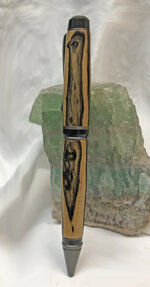egnald
Member
Hello all, A day or so ago my wife and I were going through my finished pens to pick some out to give as gifts when she picked up a nice Cigar made from Black and White Ebony and finished wiht CA. She announced "It's too bad it has that big crack in it". Wow, somehow the Grand Canyon of cracks had developed on the upper blank. I guess it didn't really surprize me because some woods like the Ebonys are prone to cracking. But what did suprize me I guess was that it just cracked on it's own, sitting in a tray in a pen box - no big temperature or humidity swings or anything. It is, of course, one of my favorite blanks as one of the black areas looks just like the neck and head of some kind of bird (to me anyway). I will most likely sand it down, re-finish it, and re-position the clip to cover any of the filled in crack that is still visible.
Ok, so does anyone have a secret for helping prevent this kind of thing from happening? I've read that some of the friction polishes help prevent micro-cracks from developing into full blown cracks. Does anyone have any experience along these lines?
Regards,
Dave
PS This is a picture before the crack appeared.

Ok, so does anyone have a secret for helping prevent this kind of thing from happening? I've read that some of the friction polishes help prevent micro-cracks from developing into full blown cracks. Does anyone have any experience along these lines?
Regards,
Dave
PS This is a picture before the crack appeared.

